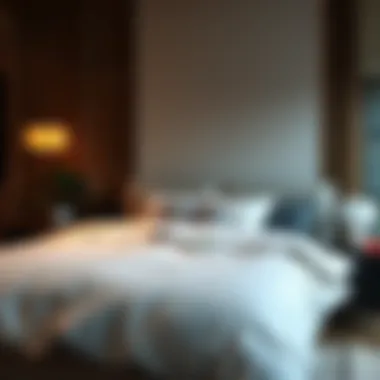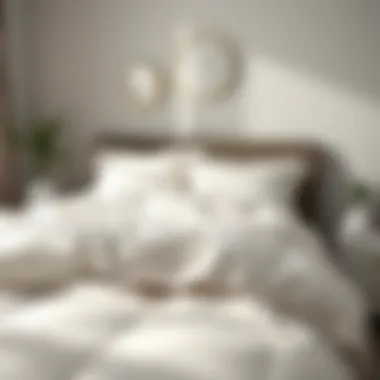Selecting Lightweight King Size Duvet Inserts for Comfort


Intro
In today’s fast-paced world, comfort and functionality in our bedrooms have become paramount. The right duvet insert can transform a bedroom from a mere sleeping space to a sanctuary of rest and relaxation. As homeowners and designers alike seek answers, the lightweight king size duvet insert stands out for its unique blend of comfort and convenience. Understanding how to select a top-notch duvet insert involves digging deep into materials, care practices, and design trends that can influence your final decision.
One must realize that not all duvet inserts are created equal. The right choice influences quality of sleep, design cohesion within your space, and even the maintenance routine of your bedding ensemble. This article aims to guide you through the essentials of selecting a lightweight king size duvet insert, shedding light on materials, maintenance, and design insights tailored for various lifestyles. With these considerations in mind, let's delve into how it all interconnects, beginning with the contemporary furniture styles and trends that dictate today’s bedding choices.
Understanding Duvet Inserts
Duvet inserts are a vital component in the realm of bedding, serving as the core element that determines not just the warmth but also the overall comfort of your sleep space. Selecting the right duvet insert goes beyond merely picking a fluffy layer to toss over your bed. It’s an integral decision that impacts your sleep quality and bedroom aesthetics alike. By grasping the nuances of duvet inserts, homeowners, designers, and retailers can make informed selections that not only enhance comfort but also bring a touch of sophistication to their living spaces.
What is a Duvet Insert?
A duvet insert is a soft, warm, and often fluffy filling that fits inside a duvet cover. Unlike comforters, which are typically stitched and filled as a single unit, duvet inserts are designed to be removable and washable. This characteristic makes them incredibly practical for those who value cleanliness and fresh bedding. Think of it as a protective layer for your bedding, insulating your body against the cold while bringing a layer of style to your decor. It’s that cozy companion that wraps you in warmth during those chilly nights.
Types of Duvet Inserts
Choosing the right duvet insert can be a bit like choosing a favorite slice of pie – there are several options to savor, each with its unique benefits. When it comes to duvet inserts, they generally fall into three broad categories: down, synthetic, and natural fiber inserts. Here’s how they stack up:
Down Duvet Inserts
Down duvet inserts are made from soft plumage found beneath the feathers of ducks or geese. This material stands out because it offers exceptional warmth without excessive weight. Down is favored for its luxurious feel and excellent insulation properties, making it a top choice for many. A key characteristic of down duvet inserts is their ability to provide warmth, while still being surprisingly light. However, there are some drawbacks; they can be a bit pricey and may not be suitable for allergy sufferers since they can harbor dust mites.
Synthetic Duvet Inserts
If you’re looking for something more budget-friendly, synthetic duvet inserts can be a wise choice. Typically filled with polyester fibers, these inserts are hypoallergenic and can mimic the lofty feel of down. Their main appeal lies in their easy maintenance and durability. Unlike down, they can be tossed in the washing machine without worry. One disadvantage, however, is that they often lack the breathability that natural materials offer, which can lead to overheating.
Natural Fiber Duvet Inserts
Natural fiber duvet inserts, often made from materials like cotton or wool, have become increasingly popular. These options are known for their breathability and moisture-wicking properties, keeping you comfortable throughout the night. They often come with the added bonus of being organic and environmentally friendly. However, it's essential to consider that they may not provide the same level of warmth as down or synthetic options, making them better suited for those living in more temperate climates or simply for summer months.
"Your choice of duvet insert can significantly affect your sleep quality, style, and the ease of maintaining your bedding set-up."
In summary, understanding duvet inserts helps you delve into a realm of diverse materials, each brimming with unique features. By weighing the pros and cons of down, synthetic, and natural fiber options, you can better navigate the market and choose a product that harmonizes comfort, practicality, and style.
The Importance of Size
When it comes to duvet inserts, size is not just a matter of fitting the cover. It plays a crucial role in ensuring comfort, practicality, and aesthetics. With king-size duvet inserts, we find ourselves navigating through benefits that particularly resonate with those aiming for a cozy and spacious sanctuary. This section delves into the reasons why opting for king-size duvet inserts can elevate your bedding experience immensely.
Why Choose King Size?
Space Considerations
Choosing a king-size duvet insert is often grounded in the sheer space it offers. When you have a larger bed, naturally, you want a duvet that complements it without looking out of place. A standard queen or full-sized duvet may leave you with awkward gaps, leading to chillier nights than expected. With more real estate to work with, king-size duvet inserts will drape elegantly over the edges of your mattress, providing coverage that enhances both comfort and visual appeal. It's a beneficial choice for anyone looking for a cohesive design that makes their bed the centerpiece of a room.
However, consider the dimensions of your bedroom furniture too—squeezing a king-size duvet in a smaller space could easily backfire, making your room feel cramped instead of cozy.
Comfort Level
Comfort is king, quite literally, when it comes to choosing the right duvet size. A king-size duvet insert promotes a relaxed sleeping experience as it ensures that both partners can enjoy ample coverage without chilly drafts sneaking in. The added size means fewer late-night tugs and pulls; you won’t wake up in the middle of the night cold or tangled in your bedding. Particularly if you or your partner tend to move around a lot during sleep, this size helps maintain that comfortable cocoon feeling throughout the night.
On the flip side, if your mattress is on the smaller side, bedding that overtakes the bed could become cumbersome, impacting ease of movement and causing unnecessary frustration.
Design Aesthetics
Beyond the practical aspects, the design aesthetics of a king-size duvet insert cannot be overstated. A large duvet can serve as an artistic focal point in your bedroom, allowing you to play with colors, patterns, and textures in ways that smaller sizes simply can’t match. Whether it’s a bold, patterned duvet or a luxurious quilt, the size fosters a sense of harmony in the design of your space. Plus, there’s something undeniably inviting about a grand, spacious bed with all the right touches.
However, one must bear in mind that using a larger duvet can inadvertently overshadow other design elements in the room. Balancing the duvet with complementary decor becomes essential; an overly loud duvet can create a jarring effect if the room’s other features are too subtle.
Measuring Your Bed for a Perfect Fit
Once you've made the thought-out decision to go king-size, the next item to tackle is measuring your bed properly to ensure a snug fit. Precision is key here. You don’t want to end up with a comforter that’s either too loose or too restricting. To avoid those last-minute disappointments, grab your measuring tape and check the width and length of both your mattress and any additional bedding like pillow tops. Keep in mind to measure the depth of your mattress as well, especially if it’s a thicker model, to ensure that the duvet can slide over it comfortably without looking absurdly small or oversized.
Overall, ensuring the right size with a king-size duvet insert does enhance not just your experience during the night, but contributes to the overall elegance of bedroom decor.
Materials Used in Lightweight Duvet Inserts
The kind of material used in your duvet insert substantially influences its performance, comfort, and even its longevity. In today's world, where everything from aesthetics to functionality matters, lightweight materials have carved out their niche in bedding. In this segment, we will dig into the advantages of lightweight materials that make them a go-to choice for duvet inserts, and also talk about the different filling options available.
Benefits of Lightweight Materials
Breathability


Breathability stands out as a key aspect of lightweight materials. It refers to the ability of the fabric to let air circulate, which is critical for maintaining an even temperature and preventing overheating. A duvet insert that allows air to flow freely not only keeps you comfortable during warm nights but also helps to wick away moisture.
One reason breathability is attractive is that it gives a reassuringly fresh sleeping environment. You know how it feels to be trapped under layers of heavy fabric that might as well be a suffocating cloud? With breathable materials, that’s out the window. The downside could be that some extremely lightweight duvet inserts might not provide sufficient warmth during colder months, but they often offer an array of variations that suit seasonal needs.
Easy Maintenance
When it comes to bedding, easy maintenance is a hallmark of lightweight materials. Many lightweight duvet inserts can be machine-washed and quick to dry, making them a practical choice for everyday use. With modern lifestyles being so hectic, who has the time or energy to fuss over complicated cleaning regimens?
This characteristic makes lightweight duvet inserts incredibly appealing, especially for homeowners with busy schedules. The drawback, however, is that not all lightweight options hold up well over time. Some may lose their shape or structure after repeated washes, so it’s essential to check the care labels.
Temperature Regulation
Temperature regulation is another vital benefit of lightweight materials. This property works hand-in-hand with breathability, ensuring that a duvet insert doesn’t just allow for airflow but also helps maintain a comfortable sleeping temperature. For example, during a chilly evening, a well-designed lightweight duvet can trap just enough heat with its insulating properties while still being airy enough to prevent overheating when the temperature rises.
It's a dual advantage that many homeowners often overlook. The con is that, like breathability, the effectiveness of temperature regulation can vary between products. A lightweight duvet insert that excels in view of temperature regulation might not appeal to every sleeper, particularly those who prefer the enveloping warmth of heavier alternatives.
Common Lightweight Filling Options
Microfiber
Microfiber is a synthetic material celebrated for its softness and lightweight nature. Plying tight fibers together makes it efficient at mimicking natural down feather fills while also being hypoallergenic. It’s particularly beneficial for those prone to allergies or looking for non-animal fill options. The affordability also makes it a popular choice among budget-conscious consumers.
However, being synthetic, it may not breathe as well as natural fills, so in humid conditions, it might lead to a stuffy experience.
Polyester
Polyester is another common lightweight filling, rising in popularity thanks to its durability and resistance to wrinkles. It’s generally less expensive than many natural fibers, making it budget-friendly. Additionally, polyester duvet inserts can often provide considerable warmth without the weight, striking a balance between comfort and usability.
One downside is that polyester may not offer the same luxurious feel as down or silk—which could matter if you’re aiming for a higher-end bedroom style.
Silk
Silk is often regarded as the cream of the crop of lightweight materials. It provides an unmatched luxurious experience and is also excellent for temperature regulation, keeping you cool in summer and warm in winter. This material adds a touch of elegance to any bedroom setup, making it a great option for those wishing to elevate their decor.
On the flip side, silk can be considerably pricier and may require special cleaning care, which detracts from its practicality. Still, if you are after a blend of sophistication and functionality, silk has plenty to offer.
Lightweight duvet inserts are not merely a trend; they represent a modern approach to comfort, intertwining style and practicality.
These discussions on materials highlight that choosing the right fabric for your duvet insert can significantly impact your sleeping experience. In a world where both comfort and aesthetics matter, paying attention to the materials used can enhance your overall satisfaction with your bedding.
Choosing the Right Lightweight King Size Duvet Insert
Choosing a duvet insert isn't just an afterthought; it's a pivotal choice that influences both comfort and aesthetic in your bedroom. The right lightweight king size duvet insert is not only about ensuring warmth but also about enhancing your sleep quality without burdening you with excessive weight. This decision can make a world of difference, especially for those who toss and turn throughout the night.
When selecting a duvet insert, several elements come into play. Lightweight options can provide snug warmth while remaining easy to handle and maintain. This section focuses on key features every buyer should weigh carefully, from fill power to the quality of the cover fabric. Each aspect contributes significantly to your overall sleep experience and the visual appeal of your bedding.
Key Features to Consider
Fill Power and Loft
Fill power refers to the volume occupied by one ounce of down or fiber. It’s a crucial factor when assessing the effectiveness of duvet inserts. Higher fill power typically means a lighter duvet that offers more warmth without the added heft. This makes it a popular choice for those who prefer lightweight warmth, as it allows for ease of movement during sleep while ensuring you stay toasty. A unique feature of high fill power is its ability to trap air, creating insulation that feels lofty without weighing you down.
Advantages:
- Lightweight and warm, making it ideal for year-round use.
- Versatile for various climates, ideal for fluctuating temps.
Disadvantages:
- Higher fill power inserts can come with a heftier price tag.
Weight and Warmth
The weight of your duvet plays a significant role in your comfort, especially for those who dislike feeling pinned down by heavy bedding. Lightweight models provide a balance between warmth and comfort, allowing you to enjoy the feeling of being snuggled without feeling buried. Striking the right balance is essential. Too light may leave you chilly, while too heavy can disrupt your slumber. The right weight facilitates a cozy, enveloping feel while also being easy to shake out or rearrange during the night.
Advantages:
- Comfortable for various sleeping positions and movements.
- Easy to launder and maintain.
Disadvantages:
- Some lightweight options might not provide enough insulation for colder months.


Cover Fabric Quality
The quality of cover fabric extends beyond mere softness. A fabric that breathes well enhances the overall comfort of your duvet insert. If you’re leaning towards lightweight options, materials like cotton or bamboo are excellent choices, offering both durability and breathability. An added perk is their softness against your skin, which can make a significant difference in your overall sleeping experience. Furthermore, the right fabric prevents heat retention, allowing for better temperature regulation throughout the night.
Advantages:
- Increases durability while ensuring warmth.
- Enhances aesthetics with various patterns and colors.
Disadvantages:
- Higher quality fabrics may increase initial investment.
Assessing Warmth Levels
Seasonal Variants
When assessing warmth levels, it’s crucial to consider seasonal variants. Not all duvet inserts are created equal—some are designed specifically for winter, while others are perfect for summer. Having options that cater to the specific needs of the seasons allows for greater comfort and adaptability to changing temperatures. A lightweight duvet can serve as a cozy layer in winter while remaining breathable in summer.
Advantages:
- Flexible use throughout the year, ensuring comfort.
- Reduced need for multiple bedding pieces, saving space.
Disadvantages:
- May require additional investment to have season-appropriate options.
Personal Comfort Preferences
Personal comfort preferences vary widely among sleepers. Some may relish the feeling of a heavier duvet, while others prefer the airy feel that a lightweight insert can provide. It's imperative to gauge your own comfort needs when selecting a duvet insert. Test out different options in-store and consider your typical sleeping habits before making a decision. This mindfulness ensures you're investing in a bedding solution that aligns with how you like to sleep.
Advantages:
- Customized comfort leads to better quality of sleep.
- Encourages satisfaction with your bedding choice, avoiding returns.
Disadvantages:
- Different preferences within a shared bed can complicate choices.
By carefully considering these elements, you can better navigate the plethora of options available, leading to an informed decision that enhances your sleeping habits and bedroom design.
Maintenance and Care for Duvet Inserts
Keeping a duvet insert in good shape isn't just about aesthetics; it hugely impacts its longevity and your overall comfort. A well-maintained duvet can offer warmth and softness for years, while an overlooked one might turn into a lumpy disappointment. Let's dive into some key care tips that will keep your duvet insert in splendid condition.
Cleaning and Washing Guidelines
When it comes to cleaning your duvet inserts, adherence to guidelines can prolong their life. Many inserts come with washing instructions stitched right into the care tag, which can be a useful starting point. Here are a few general pointers:
- Frequency: Aim to wash your duvet insert at least once or twice a year. If you live in a particularly humid climate or have allergies, consider washing it more often.
- Detergents: Use a mild detergent without harsh chemicals to prevent any potential damage to the fabric or filling. Softening agents can sometimes do more harm than good, so it's best to avoid them.
- Washing Machine: If it fits comfortably, wash it on a gentle cycle with cold water. A front-loading machine can be gentler on the fabric, allowing for a more thorough clean without the risk of snags.
"Regular care not only refreshes your duvet but can also help avoid that annoying musty smell that sometimes sneaks in!"
- Drying: Always dry your duvet thoroughly on a low heat setting. Adding tennis balls or dryer balls can help redistribute the filling and prevent clumping during the drying process. Be patient with this step, as a duvet that's damp inside can lead to mildew.
Storage Recommendations
When the seasons change, knowing how to store your duvet is essential. Here are two key aspects to consider:
Proper Folding Techniques
Proper folding techniques don't just make your storage look neat; they also prevent unnecessary creasing and ensure your duvet maintains its shape. Here’s how to do it:
- Lightly stuff: Don't force the duvet into a tight fold. Instead, gently stuff it to prevent the filling from clumping.
- Smooth it out: As you fold, smooth the fabric to banish any wrinkles.
- Avoid extreme temperatures: Store in a cool, dry place to hinder mold or mildew growth.
The act of folding properly keeps your duvet looking fresh, and it also minimizes the risk of damaging what can be a hefty investment.
Choosing the Right Bags
Using appropriate bags for storage is crucial. Opt for breathable fabric bags rather than plastic. Plastic can trap moisture and foster mold, which is a real nightmare.
- Material choice: Cotton or linen bags allow the duvet to breathe, preventing any musty smells.
- Size matters: Make sure your bag is spacious enough. Stuffing your duvet into a small area can cause uneven filling distribution.


Investing in the right storage solutions creates optimal conditions for your duvet and ensures it stays in prime condition, ready for those chilly nights.
Keeping duvet inserts clean and nicely stored is not just a chore; it's a meaningful element of home care that significantly affects your bedroom’s vibe and functionality. When maintained properly, these inserts can offer a cozy retreat, transforming your sleep sanctuary into a haven of comfort.
The Role of Duvet Inserts in Interior Design
In the realm of interior design, duvet inserts are not mere functional items, but essential components that contribute significantly to the overall aesthetic and comfort of a space. A well-chosen duvet insert can elevate a bedroom’s style while ensuring a cozy ambiance. The integration of these inserts into the bedroom design goes beyond just color or style compatibility, it encapsulates an understanding of various elements that enhance both appearance and comfort.
Enhancing Bedroom Aesthetic Appeal
Color Coordination
Color coordination in bedding plays a pivotal role in creating harmony within a bedroom. When selecting a duvet insert, considering its hue and pattern in relation to the rest of the room decor is crucial. A duvet in shades that complement the wall color and other textiles can bring a sense of cohesiveness that is visually pleasing. For instance, if the bedroom features a muted palette dominated by grays and whites, a vibrant quilted duvet insert in shades of deep blue can serve as an arresting focal point, infusing life into the decor.
The key characteristic of color coordination lies in its ability to balance contrasting elements. This makes it not just a practical choice, but also a preferred method among designers seeking to unify disparate styles. A well-coordinated duvet can play a unique role in softening harsh lines or contrasting textures prevalent in modern decor styles, making the choice of a duvet insert not just about functionality but about creating a desired mood in the space. However, it’s important to take care not to over-saturate the color scheme, as it might lead to a cluttered appearance.
Textural Considerations
Textural elements are another cornerstone of bedroom design. They can dramatically influence how a space feels and is perceived. When choosing a duvet insert, different textures such as smooth silk or fluffy down can impart distinct sensations and styles. A duvet made of soft cotton can offer a casual, inviting feel, while a heavier fabric could lend a more luxurious vibe.
The unique feature of texture in bedding is its duality: it not only contributes to the comfort of the sleeping experience but also enriches the visual landscape of a room. For example, layering duvet inserts with contrasting textures may create depth and interest, transforming a simplistic design into something far more engaging. Choices should aim for complimentary textures that work in tandem rather than clash. If achieving a dreamlike atmosphere is the goal, incorporating materials that juxtapose sleekness with warmth often leads to a well-designed result.
Creating a Cozy Atmosphere
A duvet insert plays a crucial role in establishing a cozy atmosphere within the bedroom. It acts as a personal sanctuary, a space where relaxation must reign. The choice of a lightweight duvet can enhance this comfort factor while still allowing for aesthetic appeal. The combination of a visually striking duvet with soft, welcoming materials can make a bedroom feel more inviting.
Additionally, the lighter weight of specific duvet inserts can facilitate comfort in various seasons, allowing individuals to adapt the bedroom setting according to temperature changes without sacrificing style. By ensuring that the duvet insert complements not only the decor style but also evokes warmth and comfort, homeowners can truly maximize the emotional impact of their sleeping spaces.
"A duvet insert doesn’t just provide warmth at night; it lays the foundation for a personally curated aesthetic that transforms an ordinary bedroom into a retreat."
With the awareness of how duvet inserts influence interior design, homeowners and designers alike can make informed choices that extend far beyond practicality. Instead, they can craft spaces that reflect personal style while ensuring comfort and warmth. Listening to these principles will invariably lead to more satisfied spaces and restful nights.
Trends in Duvet Inserts
The world of duvet inserts is evolving, much like the broader landscape of interior design and home textiles. Consumers today are more discerning than ever, seeking products that align with their values and lifestyle. Consequently, staying updated on trends in duvet inserts is crucial for homeowners, designers, and even retailers who wish to meet the demands of modern living.
One key element making waves is the growing emphasis on sustainability. With climate concerns at the forefront of many conversations, duvet manufacturers are increasingly exploring eco-friendly materials and processes. The ability to sleep peacefully under a duvet made from responsibly sourced materials offers not only comfort but also a unique selling point for producers. This trend goes beyond mere buzzwords, as it reflects a shift towards mindful consumption.
Another interesting aspect of contemporary duvet inserts involves innovative designs and features. With an eye on both utility and aesthetics, manufacturers are catering to varied consumer preferences. Gone are the days when a duvet was simply a functional item; it now serves as a crucial design component in bedrooms. The blend of practicality and style is a prevalent theme that continues to shape choices.
In summary, staying attuned to trends in duvet inserts not only enhances the individual’s sleeping experience but also aligns with broader values of sustainability and design innovation. This knowledge can guide homeowners to make informed choices that elevate their living spaces, ensuring comfort and visual appeal in equal measure.
Sustainable Materials in Duvet Production
The trend towards sustainable materials in duvet production is transforming not just what we sleep under, but how we perceive our impact on the planet. Natural fibers like organic cotton and bamboo are gaining popularity, prized for their breathability and soft touch. Meanwhile, down alternatives made from recycled plastics highlight a commitment to reducing waste.
This sustainability push also caters to those who may suffer from allergies, as many natural fibers are hypoallergenic. While synthetic options have served the market well, there's a palpable shift towards finding materials that are both gentle on the body and kind to the earth. Purchasing decisions are increasingly influenced by an understanding of environmental footprints, prompting consumers to seek those producers who prioritize sustainable practices.
Innovative Designs and Features
As the duvet market evolves, innovative designs and features are becoming central to consumer purchasing behavior. Two noteworthy trends in this area are Smart Bedding Technology and Customizable Duvet Options. These advancements allow users to tailor their sleeping experiences in ways that were previously unimaginable.
Smart Bedding Technology
Smart bedding technology is a trailblazer in bedroom innovation. Often integrated with apps, this technology helps users keep tabs on their sleep patterns. The ability to adjust temperature settings or even firmness levels with a swish of a finger makes it a hot commodity in contemporary bedding. Key features often include temperature control and moisture-wicking capabilities, all made possible through advanced fabrics.
This technology is not simply a fad; it's a meaningful way to improve sleep quality. Many homeowners find that well-rested nights lead to energized days, creating a compelling case for investment. However, potential buyers should weigh advantages, like enhanced comfort, against disadvantages, such as possible tech malfunctions or higher price points.
Customizable Duvet Options
Customizable duvet options represent another layer of personalization. This variety allows consumers to select the fill type, weight, and even fabric to suit their specific needs. A person living in a warmer climate may choose a lightweight synthetic fill with a breathable cotton cover, while someone in a cooler area might opt for a heavier down alternative for warmth.
This adaptability in design is appealing, as it enables a tailor-made approach. One notable feature is the option to choose colors and patterns, allowing for alignment with existing decor or personal tastes. While the advantages are enticing—enhanced comfort and style—underselling the disadvantages like potential overcomplication or market confusion would be a mistake.
In embracing these trends of sustainability and innovation, the duvet insert industry is not just keeping pace with consumer desires but also elevating the entire sleeping experience, making it a truly worthwhile pursuit.
Epilogue
When it comes to creating a comfortable and stylish bedroom, the choice of duvet inserts cannot be underestimated. The importance of selecting a lightweight king size duvet insert cannot be overstated, especially as many seek both functionality and aesthetics in their living spaces. Lightweight options offer numerous benefits, ensuring you stay cozy without feeling weighed down, which is particularly essential for those who enjoy adjusting their bedding for different seasons or personal preferences.
Final Thoughts on Lightweight King Size Duvet Inserts
A lightweight king size duvet insert brings together practicality and luxury. As homeowners, designers, and DIY enthusiasts explore options, they are likely to find the following points resonate strongly:
- Versatility: A lighter duvet can be used across various seasons. It tends not to trap heat, making it suitable for warmer months while still providing adequate warmth during cooler periods.
- Ease of Care: Maintaining a duvet that is lightweight often involves simpler washing and drying processes. Many of these materials are machine washable and dry quickly, which is a boon for busy households.
- Enhanced Aesthetics: Lightweight duvet inserts allow for better draping over beds, enhancing the overall look. They adapt to various styles, whether it’s a minimalist design or something more traditional.
- Sustainable Choices: As the trend for environmentally-friendly materials grows, many lightweight options boast sustainable and ethically-sourced fillings, contributing to a healthier planet.
In summary, choosing a lightweight king size duvet insert not only caters to personal comfort preferences but complements contemporary design ideals. With materials that breathe, warm up efficiently, and look good, these duvet inserts stand out as an essential component in modern bedding solutions. For any discerning individual looking to elevate their sleeping space, a lightweight king size duvet insert might just be the ticket.















